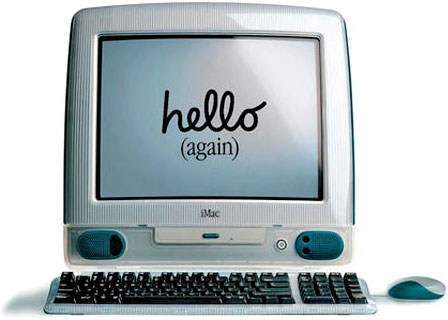In the mid 1990s, Apple’s products were less than up to par. The Performa line had constant problems (such as the 5200, which had a recall on the display cable), and PowerBooks were rather slow and also problematic (like the 5300, which had recalls on the battery, logic board, and various plastic case parts).
Of course, once these problems were fixed, the computers generally worked well. That is, assuming that you don’t consider how buggy System 7.5.1 was on PowerPC-based Macs and how the Mac software of the time (a certain Microsoft product comes to mind) wasn’t very good compared to the Windows version.
Simple Is as Simple Does
 Then came the iMac, the computer that was the top-selling model of the late 90s. It was pretty much un-upgradeable – except for the RAM and hard drive – and was completely incompatible with almost every device that existed in the computing world.
Then came the iMac, the computer that was the top-selling model of the late 90s. It was pretty much un-upgradeable – except for the RAM and hard drive – and was completely incompatible with almost every device that existed in the computing world.
And it had no floppy drive.
Most people were amazed that it sold so well. It was so basic, yet there were waiting lists for them!
That’s because until then just about every computer company completely ignored consumers who wanted something simple, something that would get them online so they could do email.
Sure, in 1994 Compaq had their all-in-one Presario 500 series, and Apple had its Performa 500 and 5000 series, but these were marketed as “multimedia computers” – basically computers that could do anything and everything you and your family wanted. Both Compaq and Apple put a whole bunch of expansion ports and add-on slots in these machines, and, like all the other computers out in 1995, they were ugly.
The iMac was a newer variation of the multimedia computer, but it was marketed differently. It was marketed as “Step one: Plug it in. Step two: Turn it on. Step three: There is no step three!”
This was exactly the machine that the computer-intimidated needed in 1998.
More
It’s moved up from there. Those who knew very little about computing in 1998 all of a sudden had new needs, as their original iMac has got them involved and interested in using the computer. They want to be able to connect their digital camera effortlessly. They want to be able to use an MP3 player. They wanted the additional capabilities so their system could expand with their needs (the original iMac lacked a lot of that).
Apple realized this. Newer iMacs added options for wireless networking, Bluetooth, and now come standard with FireWire ports and a video-out port to support a second display.
It’s no longer just a “There is no step three” computer. It’s a simple-to-use computer that can grow with a users’ knowledge of computing. And that’s not even mentioning the additional improvements in Mac OS X 10.3 Panther compared to Mac OS 8.1 and 8.5 that shipped with older iMacs.
 Apple’s had its little issues, though. The G4 Cube was a marketing disaster. It was too expensive ($1,799 to $2,299), not upgradeable enough, didn’t have enough features to compensate for the price, and the models that did get sold had too many problems with the touch-sensitive power switch on the top (which should have probably been called “brush-sensitive”).
Apple’s had its little issues, though. The G4 Cube was a marketing disaster. It was too expensive ($1,799 to $2,299), not upgradeable enough, didn’t have enough features to compensate for the price, and the models that did get sold had too many problems with the touch-sensitive power switch on the top (which should have probably been called “brush-sensitive”).
Further, there was no clearly defined market for the Cube. Professionals didn’t want it, because they couldn’t install additional hard drives or PCI cards. Home users didn’t want it, because they figured out that buying the 400 MHz G4 tower for $1,599 was not only cheaper, but they’d have the additional expandability if they ever wanted to add anything to their system.
Apple has obviously learned from their mistake. The “new Cube” (the Mac mini) has a clearly defined market – those switching from Windows.
Changing Times
Apple’s a lot more fashionable today than it was five years ago. “Oh, you have a Macintosh?” has gone from implying disdain to implying a certain curiosity – “Hmm, I’ve never thought about buying one, maybe I should.”
I think a lot of that popularity isn’t due to anything Apple’s done but to the increasing problems with Windows. Windows XP is a four-year-old operating system and has more viruses, worms, spyware, and adware then anyone should have to deal with. (I’m not blaming Microsoft here; if XP had 10% of the market, there’d be a lot fewer problems.)
Internet Explorer 6 has far too many issues, too, and this is Microsoft’s fault. They haven’t done enough to keep their browser up to date, and people are starting to dislike it more and more.
Apple’s Mac OS X is finally working like it should – no more System 7.5.x “Type 2 Error” and Mac OS 8.0 “There is a problem with the control panel Apple Menu Options” issues. And Mac software is actually decent for once in quite some time.
It’s excellent luck for Apple. All they need to do is put out products people want to buy – and so far they’re doing just that.

